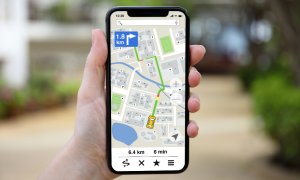In today’s fast-paced business environment, IoT Fleet management has become increasingly crucial to the success of various industries such as logistics, transportation, and delivery. With the advancement of technology, fleet management has evolved beyond simply tracking vehicles’ locations and optimizing routes. The integration of the Internet of Things (IoT) has revolutionized the way fleet management is conducted.
By utilizing IoT devices, fleet managers can now gather real-time data on a vehicle’s location, speed, fuel consumption, and more. This data allows for proactive decision-making, better resource allocation, and improved efficiency. In this blog, we will explore the benefits of IoT fleet management and how it is used in industries.
Fleet Management using IoT
Fleet management using IoT is a comprehensive software solution used by companies to manage their fleet of vehicles efficiently. This system, also known as an IoT fleet management system, offers a range of features designed to help businesses optimize the use of their vehicles, reduce costs, and improve productivity.
The system provides real-time tracking, analysis, and reporting of various aspects of fleet operations, including vehicle maintenance, fuel consumption, driver behavior, and safety.
Here are 12 key features of a Fleet Management System:
GPS Tracking:
Real-time tracking of vehicles’ location and movement using GPS technology.
Vehicle Maintenance:
Scheduling and tracking of vehicle maintenance to ensure vehicles are in good condition.
Fuel Management:
Monitoring of fuel consumption and fuel expenses to reduce costs and optimize fuel usage.
Driver Management:
Tracking of driver behavior and performance to improve safety and efficiency.
Route Optimization:
Planning of the most efficient routes for drivers to reduce travel time and distance.

Compliance Monitoring:
Ensuring that vehicles and drivers are compliant with legal and safety regulations.
Inventory Management:
Tracking of inventory and supplies carried by vehicles for efficient delivery and restocking.
Dispatch Management:
Assigning and monitoring of tasks and deliveries to drivers.
Vehicle Diagnostics:
Remote diagnostics and monitoring of vehicles to detect and resolve issues before they become problems.
Driver Safety:
Promoting safe driving practices by monitoring and reporting on driver behavior.
Asset Management:
Tracking and managing of all assets associated with the fleet, including vehicles, equipment, and tools.
Analytics and Reporting:
Generating reports and analytics on various aspects of fleet operations to help managers make data-driven decisions.
IoT Fleet Management Features:
IoT fleet management refers to the use of connected devices and sensors to track, monitor, and manage a fleet of vehicles. This technology enables fleet managers to optimize their operations, improve efficiency, and reduce costs. There are many key features of an IoT fleet management system, some of which are outlined below. For more detailed information, refer to the blog “10 Transportation Fleet Management System Best Practices.”
Real-time tracking: IoT fleet management systems provide real-time tracking of vehicles, enabling fleet managers to monitor their location, speed, and status.
Geofencing: This feature allows managers to set virtual boundaries around a specific area, triggering alerts if vehicles move beyond them.
Route optimization: IoT fleet management systems can help optimize routes for drivers, minimizing travel time and fuel costs.
Predictive maintenance: IoT sensors can be used to monitor the health of vehicles, predicting when maintenance is required and preventing breakdowns.
Fuel management: These systems can monitor fuel usage, identify inefficiencies, and reduce fuel costs.
Driver behavior monitoring: IoT fleet management systems can track driver behavior, identifying unsafe practices and improving overall safety.
Electronic logging: IoT systems can automate the process of logging hours of service, ensuring compliance with regulations.
Inventory management: These systems can track inventory levels on vehicles, helping managers plan restocking and reduce theft.
Temperature monitoring: IoT sensors can monitor the temperature inside refrigerated vehicles, ensuring that goods are transported at the correct temperature.
Remote diagnostics: IoT systems can diagnose and troubleshoot vehicle issues remotely, reducing downtime and repair costs.
Asset tracking: IoT fleet management systems can track and manage other assets, such as trailers or equipment.
Driver communication: These systems can facilitate communication between drivers and managers, improving collaboration and efficiency.
Safety alerts: IoT fleet management systems can trigger safety alerts, such as speeding or harsh braking, helping to reduce accidents and insurance costs.
Analytics and reporting: These systems can provide detailed analytics and reporting, giving managers insights into vehicle and driver performance, as well as identifying areas for improvement.
What are IoT, IIoT, and their characteristics?
IoT stands for the “Internet of Things,” which refers to a network of physical objects, such as devices, appliances, and machines, that are embedded with sensors, software, and connectivity, enabling them to collect and exchange data over the Internet.
IIoT stands for “Industrial Internet of Things,” which is a subset of IoT that focuses on industrial applications, such as manufacturing, logistics, and energy, by leveraging connected devices and sensors to optimize processes, reduce costs, and enhance productivity.
Key Features of IoT:
- Connectivity: IoT devices are connected to the internet, allowing them to exchange data with other devices and systems.
- Sensors: IoT devices are equipped with sensors that can detect changes in the environment, such as temperature, humidity, and light.
- Data analysis: IoT devices generate large amounts of data, which can be analyzed to extract insights and improve decision-making.
- Automation: IoT devices can be programmed to perform specific actions based on predefined rules or conditions.
- Interoperability: IoT devices are designed to work together, regardless of their manufacturer or technology.
- Scalability: IoT networks can be easily scaled up or down to accommodate a growing number of devices and users.
Key Features of IIoT:
- Real-time monitoring: IIoT devices provide real-time data on industrial processes, enabling operators to detect issues and make quick decisions.
- Predictive maintenance: IIoT devices can predict when a machine or component is likely to fail, allowing for proactive maintenance.
- Energy efficiency: IIoT devices can monitor energy consumption and optimize usage to reduce costs and environmental impact.
- Enhanced safety: IIoT devices can monitor and control hazardous processes, reducing the risk of accidents and injuries.
- Supply chain optimization: IIoT devices can track inventory levels and monitor logistics, optimizing supply chain management.
- Machine-to-machine communication: IIoT devices can communicate with each other to coordinate processes and improve efficiency.
What Is the Main Use of Fleet Management Tool?
Fleet management tools are software solutions designed to help businesses efficiently manage their vehicle fleets. The main use of fleet management tools is to improve overall fleet performance and reduce operational costs by providing real-time data and insights into fleet operations.
Here are the top 7 uses of fleet management tools:
- Vehicle tracking: Fleet management tools allow businesses to track the real-time location of their vehicles, enabling them to monitor driver behavior and optimize routes.
- Maintenance scheduling: These tools help businesses schedule vehicle maintenance, such as oil changes and tire rotations, to keep their vehicles running smoothly andreduce downtime.
- Fuel management: Fleet management tools can help businesses track fuel consumption and identify opportunities to reduce fuel costs.
- Driver management: Fleet management tools allow businesses to monitor driver behavior, including speeding, harsh braking, and acceleration, and provide feedback to drivers to improve safety and efficiency.
- Compliance management: These tools help businesses comply with regulations related to driver hours of service, vehicle inspections, and other requirements.
- Inventory management: Fleet management tools can help businesses manage inventory levels, track deliveries, and optimize inventory replenishment.
- Analytics and reporting: Fleet management tools provide businesses with data analytics and reporting capabilities to help them make informed decisions about fleet operations and identify opportunities for improvement.
IoT Fleet Monitoring
IoT fleet monitoring refers to the use of Internet of Things (IoT) technology to track and manage a fleet of vehicles or assets. This technology enables fleet managers to gather real-time data on their vehicles, monitor driver behavior, optimize routes, and ensure the safety of their assets. Here are seven key features of IoT fleet monitoring:
GPS tracking: IoT fleet monitoring systems use GPS technology to track the location of each vehicle in the fleet. This allows fleet managers to monitor the real-time location of their vehicles, optimize routes, and improve overall efficiency.

Real-time monitoring: With IoT fleet monitoring, fleet managers can receive real-time alerts about issues such as maintenance needs, driver behavior, or unauthorized vehicle use.
Driver behavior monitoring: IoT fleet monitoring systems can track driver behavior, including speed, braking, and acceleration, to identify potential safety issues and reduce the risk of accidents.
Predictive maintenance: IoT fleet monitoring can also use predictive analytics to identify potential maintenance issues before they occur, allowing fleet managers to proactively schedule repairs and avoid costly downtime.
Fuel monitoring: IoT fleet monitoring systems can track fuel consumption in real-time, allowing fleet managers to identify inefficiencies and reduce fuel costs.
Geofencing: With geofencing capabilities, IoT fleet monitoring systems can set boundaries around specific areas or routes, alerting fleet managers if a vehicle deviates from its designated path.
Data analytics: IoT fleet monitoring generates large amounts of data, and advanced analytics tools can be used to analyze this data and identify trends and opportunities for improvement.
FAQS: What Are the Benefits of IoT Fleet Management and How it is used?
How does IoT work?
The Internet of Things (IoT) ecosystem is made up of web-enabled smart devices that use embedded systems, such as processors, sensors, and communication gear, to gather, send, and act on the data they get from their surroundings. By connecting to an IoT gateway or other edge device, which either sends data to the cloud for analysis or analyzes it locally, IoT devices exchange the sensor data they collect. These gadgets converse with other similar devices on occasion, acting on the data they exchange.
Conclusion:
IoT technology is increasingly being used in IoT fleet management to track and monitor vehicle performance, fuel consumption, driver behavior, and more. Benefits include improved safety, efficiency, and cost savings. With its expertise in IoT solutions, QodeNext can help businesses optimize their fleet management processes through advanced data analytics and real-time monitoring. Check this blog How to Select a Fleet Management Solution. Contact QodeNext today to learn more about how our solutions can benefit your fleet management needs.







